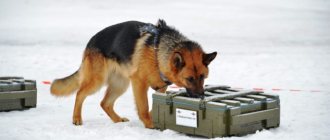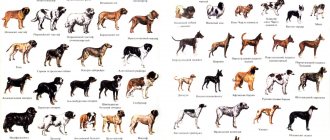Many residents of the country are interested in the exact term: what is the name of the police with dogs. In history, the name of those who train and train an animal for military and service activities has been established as a dog handler. The history of the formation of special organizations for training service dogs goes back to the 19th century, and its development extends to the present day. Who are police dogs, the features of this activity - all this is discussed in the article.
Police dog
Historical excursion
The concept of a police dog first began to be used in 1893. The potential of man's four-legged friends was noticed and revealed by the founder of criminology, the famous Hans Gross. According to him, the search for a criminal using a dog’s scent significantly speeds up the search for a criminal.
For the first time, police dog training began in Germany. Animals have been used in more than 400 law enforcement departments. The result exceeded all expectations. After the work, representatives from other countries became interested in specially trained animals.
Why are dogs hired?
In theory, a dog of any breed, with proper training, socialization, and systematic training, can become a service dog, show its maximum potential and be useful to humans.
It is believed that the natural ability of a dog to track its prey by smell (footprints) began to be used in solving crimes, searching and apprehending criminals, starting in 1896. The Austrian investigator Hans Gross convinced the world that our smaller brothers are ideal for investigative work. Thus, in the city of Hildesheim, for the first time, 12 dogs were selected, who completed a special training course and later successfully worked in the police.
The first to use his pet bull terrier in stopping a gang was Scottish policeman Malcolm Gillepsie in 1816. His faithful dog scared the horses on which the criminals were escaping and thanks to which the bandits were neutralized and taken to the police station.
Important! In Russia, dogs were first used in police services in St. Petersburg in 1906. And already in 1909, on June 21, a professional holiday was officially approved - the Day of the canine units of the Ministry of Internal Affairs.
Today it is difficult to imagine the work of intelligence services without the participation of different breeds of dogs. Four-legged friends are used in the police, the Ministry of Emergency Situations, the Ministry of Internal Affairs, the search, border services, and military affairs.
Among dog professions we can distinguish:
- Saperov. They look for explosives and explosive devices by smell.
- Rescuers. Rescue dogs are used in the emergency services of the Ministry of Emergency Situations. They take part in fires. They work on wrecks and in places of natural disasters. They help find people under the rubble. When completing tasks, a bell is tied to the animal's collar. In this way, the dog handler will be able to find the dog, because the dog may accidentally fall into the ruins.
- Border guards. All border services use dogs. They help in the fight against smugglers and prevent illegal crossing of state borders.
- Bloodhound. Dogs, thanks to their well-developed sense of smell, help intelligence services not only in searching for people and detaining criminals “on the trail,” but also in identifying smuggled caches of narcotic or other dangerous substances. Sniffer dogs work in the police and border services.
- Guards, escorts. They work as security guards at sensitive, important strategic facilities.
Faithful four-legged friends significantly facilitate the work of special structures, faithfully performing their difficult service.
In the structures of the Ministry of Internal Affairs, the canine service uses specially trained dogs for:
- establishing the route of criminals;
- protection of important objects;
- examination of territories, terrain, premises, vehicles to search for items that were lost or related to crimes committed;
- odor recognition based on an object given to the dog, seized from detained criminals;
- security of public events;
- search for corpses, people, weapons, drugs;
- to pursue persons who have committed crimes or missing people “hot on their heels.”
Different breeds of dogs are specially trained and used for different jobs.
Service dog breeding in Russia: history
Dogs for police service in Russia began to be used only at the end of the 19th century. However, in our country the structure itself was fragmented and lacking a unified system. Based on German experience, at the beginning of the 20th century, special societies were created for the training and use of dogs in police service. This activity was patronized by the royal family.
Dogs for the police were taken from a specially formed kennel, which was founded in 1909. At the same time, the first school for guide dogs opened. At that time, only Dobermans and German shepherds were selected from all breeds.
Development of service dog breeding in the Soviet years
In the years following the first wars of the 20th century, the entire system fell into disrepair. A large number of developments related to education and training were destroyed. The then famous scientist V.V. Yazykov got involved in the case.
In fact, he had to rebuild the system of breeding and training service dogs. The scientist’s efforts were not in vain. His actions led to the beginning of mass animal training. Subsequently, this led to the solving of a large number of cases and the capture of numerous criminals.
War years
The years of the Great Patriotic War led to the fact that service dogs were retrained as military dogs. Animals had to rescue the wounded, search for mines, lay telephone lines and even blow up tanks.
Attention! The contribution of four-legged friends to the victory over Germany was so enormous and significant that on Victory Day these animals walked alongside the soldiers and were also considered heroes.
Dogs during the war years
Development of service dog breeding today
Now the police German shepherd, like many other breeds, is known to literally everyone. Animals are used in a wide variety of services, and their selection and training have only become more stringent. Currently in Russia:
- there are service dog breeding centers in 78 regions of the country;
- more than 7 thousand dog handlers work;
- more than 3 thousand dog handlers of the Ministry of Internal Affairs.
TOP 5 best dog breeds for police service
Each structure favors different dog breeds. Here are the TOP 5 best dog breeds for police service according to dog handlers and specialists:
- German Shepherd. This breed has unique working qualities, high intelligence, and a balanced disposition. Shepherds learn quickly. They are smart, quick-witted, courageous, hardy, unpretentious in care and maintenance and adapt to various conditions without problems. These are loyal, noble dogs who have saved more than one human life and successfully cope with tasks of varying complexity. Thanks to many years of selection, this breed has significantly improved its working and service qualities. That is why Germans are used not only in the police, but also in other structures.
Characteristics
An animal preparing to become a service animal is subject to a number of specific requirements. Among them:
- A sensitive sense of smell that can be used in any environment.
- Courage and devotion. The dog often has to risk himself to carry out orders.
- Good health, physical characteristics.
- Concentration.
- Obedience.
- Some tendency towards aggression and a developed instinct of pursuit. Without this, work will simply be impossible.
Courage and obedience are characteristic traits of police dogs.
Day of the dog handler of the Ministry of Internal Affairs. How police dog breeding appeared and developed
On June 21, Russia celebrates the Day of Cynological Units of the Ministry of Internal Affairs of the Russian Federation. These units are unique in that both people and animals serve in them. Four-legged law enforcement assistants detect narcotic and explosive substances, “take the trail” while searching for criminals, protect the safety of people at public events, and perform guard duty at objects of various significance. All this is possible thanks to the skill, dedication and hard work of their mentors - professional dog handlers who connected their path with the internal affairs bodies. Dog handlers are not only service dog trainers, but also full-fledged police officers. They personally take part in the search and detention of dangerous criminals and escorting detainees, in maintaining public order on city streets, in anti-terrorism activities and the fight against drug trafficking.
The history of service dog breeding goes back centuries. If we talk specifically about police service dog breeding, it began to actively develop in the second half of the 19th century. Perhaps one of the first incentives for the development of police canine science was the appearance of an article by Prague University professor Hans Gross, “The Gendarme’s Assistant.” It was published in one of the Austro-Hungarian police magazines. Although the possibilities of using service dogs for the needs of the police service were studied in various European countries, at the turn of the 19th - 20th centuries. Germany occupied first place in terms of the level and quality of development of police canine technology. It was in this country that the closest attention was paid to the use of service dogs for police purposes, which made it possible to create effective methods for training animals, and a system was developed for staffing army and police units with four-legged assistants.
The main police breed in Germany was the Doberman. Not every dog breed can boast such certainty in matters of pedigree as this one. It was named after its direct founder, Friedrich Louis Dobermann, who in the 1860s. worked as a tax collector in the government of the small town of Apolda in Thuringia, which was part of the Duchy of Saxe-Weimar. Due to his duty, Mr. Doberman often had to find himself in dangerous situations, so he decided to acquire a four-legged guard - an assistant. Since Friedrich Louis Dauberman combined the duties of a tax collector and director of the city shelter for homeless animals, he decided to breed the ideal guard and began crossing the dogs available in the shelter - pinschers, rottweilers, and pointers. This is how the breed appeared, named after its “founding father.” Due to the excellent qualities of a bloodhound and a guard, the Doberman became widely used in the police service in Germany, and then in other countries. In Russia and the Soviet Union from 1908 to the end of the 1940s. The Doberman also remained the main working dog of the Tsarist police, and then the Soviet police and NKVD troops. Subsequently, they decided to abandon the use of Dobermans due to their short hair, which made it impossible to use them to guard prisoners in the harsh northern climate, and their attachment to one owner - but in the police and troops, service dog trainers often changed.
Another important police breed was the Rottweiler. This breed got its name from the name of the southern German town of Rottweil (Red Buildings), whose inhabitants from time immemorial were engaged in cattle breeding and meat trading. Large and strong “butcher dogs” helped move herds, guard the pens, and when the butchers went to the market, they harnessed them to carts with meat. In the 19th century, there was a ban on the use of Rottweil dogs as draft animals, but the city's butchers continued to keep them for security purposes. When in 1901 the German police began to organize kennels for service dogs, police officials also paid attention to Rottweilers. In 1910, the Rottweiler was officially included in the list of breeds of service dogs for the German police. When one sergeant, with the help of a Rottweiler, managed to disperse a crowd of drunken, aggressive sailors, the policeman was awarded by Kaiser Wilhelm himself, and the Rottweiler was finally recognized as an excellent police dog. However, in Russia and the Soviet Union, the use of the Rottweiler as a service dog for the police and militia was not widespread. The German Shepherd was more popular. As for Rottweilers, their active use for the needs of law enforcement agencies began at the end of the twentieth century. Today, dog handlers with Rottweilers can often be seen at public events; Rottweilers guard correctional institutions and pre-trial detention centers.
Following Germany, the first canine units began to be created in the police of the Russian Empire. In 1906, the Society for the Promotion of the Use of Dogs in Police and Guard Services was created. In 1906 - 1907 Adjutant General V.A. Dedyulin ordered the organization of a special nursery for police dogs in Peterhof. On October 19, 1908, the first all-Russian test of police dogs took place, which was attended by the Commander-in-Chief of the Guards and the St. Petersburg Military District, Grand Duke Nikolai Nikolaevich. The obvious successes of service dogs in search and security activities contributed to the decision to create a special school for police dog trainers. Full support was provided by the then Minister of Internal Affairs of the Russian Empire, Pyotr Arkadyevich Stolypin. The Society for Encouraging the Use of Dogs in Police and Guard Services was allocated a plot of land on the outskirts of St. Petersburg to establish a dog kennel and a training school. The former dacha of the Counts Stroganovs was converted into educational buildings, cadet dormitories, and a riding arena was built for training service dogs. The grand opening of the nursery and training school took place on June 21, 1909 - this is the date that is now celebrated in Russia as the Day of the Cynological Units of the Ministry of Internal Affairs.
At first, the variable staff of the school of trainers was not numerous. 20-25 people took a three-month training course. The experience of the St. Petersburg Society made it possible to open its branches in Kharkov, Smolensk and Tiflis. In 1912, among the graduates of the St. Petersburg school of trainers there were already police officers not only from the European part of Russia, but also from Turkestan and Transcaucasia. By the beginning of the First World War, more than 500 handlers and trainers served in the police and gendarmerie, and more than 100 service dog kennels were created.
One of the founding fathers of police dog breeding in Russia was Vasily Ivanovich Lebedev (1868-1930) - a professional detective, one of the leaders of the Russian detective police, who made a huge contribution to the popularization of cynology. A graduate of the Kyiv cadet school, six children (from 1887 to 1893), Vasily Lebedev served in an infantry regiment, and then retired and was accepted into service in the Moscow city police. There he made a serious career - in 1893 Lebedev was appointed junior assistant bailiff, and in 1900 the 32-year-old former military man became the head of the detective police. Lebedev went on business trips to Paris, Berlin, and Vienna, where he adopted the best practices of European police services in detective work, including the use of sniffer dogs. With the direct participation of Vasily Lebedev, the Russian Society for Encouraging the Use of Dogs in Police and Guard Service was created. Formally holding the post of Comrade Chairman of the Society, in fact Lebedev was its leader. He was also the editor-in-chief of the Society’s magazine “Police and Guard Dog” (1907-1914). The magazine ceased to exist due to the outbreak of the First World War.
The subsequent years of wars and revolutions became a serious test for the domestic law enforcement system. In fact, it turned out to be destroyed and after the approval of Soviet power, the law enforcement system, including the canine service, had to be created from scratch. In the end, Soviet leaders were convinced of the need to use the developments and achievements of the tsarist police and gendarmerie. But it was during the Soviet period of Russian history that the most powerful foundations of service dog breeding were laid, which are now being successfully developed by Russian police dog handlers.
Already in the early 1920s, when the country had slightly recovered from the severe consequences of the First World War and the Civil Wars, the first state service dog breeding schools and service dog nurseries were created in the Soviet Union. So, in 1923, two such cynology centers appeared - the Central Instructor Courses, later renamed the Central School of Service Dog Breeding of the Border Troops, and the Central School - a nursery for bloodhound dogs of the Criminal Investigation Department of the Administrative Directorate of the NKVD of the USSR. During the first years of their existence, service dog breeding schools experienced numerous problems associated with a number of factors. Firstly, there was a shortage of experienced instructors and training organizers. Secondly, there was no own population of service dogs, so they had to be purchased abroad.
Germany remained the main supplier of service dogs for the needs of the Soviet police. They brought, first of all, Dobermans, but short-haired dogs were poorly adapted to the climate of our country. As already written above, their use for police and security and escort needs in the regions of the Urals, Siberia, and the European North was especially difficult. The dogs often got sick, and the shortage of good medicines made it impossible to provide them with timely assistance. Nevertheless, even despite such difficult conditions, domestic cynology has developed and over several decades has become one of the best in the world. As for the “professional distribution” of breeds, German Shepherds were first used for communication needs, Airedale Terriers as ambulance dogs, Caucasian Shepherds for guard duty, and as a search dog for the Soviet police until the 1940s. the Doberman Pinscher was still used.
In the post-war period, the main working dog of the Soviet Union became the East European Shepherd, bred on the basis of the German Shepherd. In the 1930s. Soviet cynologists became concerned with breeding a breed of service dogs that would be adapted to climatic conditions. Today, the German Shepherd remains the most important working dog for law enforcement agencies. In addition to German shepherds, Rottweilers, Labradors, and spaniels are actively used for police purposes. Labradors are used to search for explosives, especially where there are a lot of people and children - after all, this dog, known for its good nature, is not prone to attacking people. Rottweilers and shepherd dogs are used to apprehend criminals. Recently, the Belgian Shepherd has been gaining popularity. She is well trained and in the hands of a skilled trainer becomes an excellent service dog, which is facilitated by the natural intelligence and good memory of Belgian Shepherds.
A unique experimental service dog, bred in the late Soviet period and gaining some popularity in post-Soviet Russia, is the “Sulimov dog”, which is more often called simply “shalaika”. It was bred by Klim Timofeevich Sulimov, a Soviet and Russian biologist who worked almost his entire life in the expert structures of the USSR Ministry of Internal Affairs. The Nenets Laika and the Central Asian common jackal were initially taken for crossing. The resulting individuals were small, well trained and had an excellent sense of smell. The first hybrids were bred back in the 1970s. and were intended to search for drugs. In modern Russia, “Sulimov’s dogs” are used by the security service of Sheremetyevo Airport. Now the “shalaikas” are refocused on searching for explosives - in the context of growing terrorist danger, this is a very important task.
Currently, canine units operate as part of almost all law enforcement agencies of the Russian Federation. The Ministry of Internal Affairs of Russia operates the Center for Canine Support of the Ministry of Internal Affairs of the Russian Federation, created to ensure coordination of the activities of internal affairs bodies in the field of law enforcement, searching for criminals through the use of service dogs, organizing regulatory, legal and logistical support for canine units of the Ministry of Internal Affairs of Russia, organizing and implementing selection, breeding, training, maintenance of service dogs in the system of internal affairs bodies. The use of service dogs for law enforcement needs does not lose its relevance today - in the age of scientific and technological progress, when new technical devices are appearing. The main thing in the canine service will always be the person - the one who trains the service dog, leads it on the trail and, which happens very often, personally takes part in detaining criminals.
Service dog training
Young dogs aged 1 to 3 years are selected for training. The general training course is 6-8 months. This time is enough to study general and special courses.
When training, two main methods are used. The first course is a game course, and is the most effective for training search dogs.
The second is taste-rewarding, leading to the formation of the closest possible contact between man and animal. Accordingly, the learning process is much faster.
Dog training
1950s
By the 1950s, various police forces were experimenting with dogs, and in 1954 a standing committee was formed to co-ordinate the breeding, supply and training of police dogs throughout the UK.
The popularity of the police dog has grown throughout the UK, with police forces both large and small employing dogs and handlers, and opening dog training schools to cater for the ever-increasing number of dogs in use. The value of a police dog has been universally recognized to the extent that there are over 2,500 police dogs in use among the various police forces in the UK.
You may have heard that police dogs are taught German commands so that only the handler can command them to attack and no one else can accidentally give them that important command. While this may seem like it makes sense, it is actually a myth.
This material was prepared and kindly passed on to us
Historical consultant David Rowland. International Center for the History of Crime, Policing and Justice. London. Great Britain
We recommend
Let's walk along the streets and avenues of the cities.
We go out into nature.
Shall we cook something delicious?
Let's visit the sights
Share link:
Detection Dog Skills
During the pet's training, he is taught not only general command options, but also the special skills necessary for detective work. First of all this:
- The ability to detain and escort a criminal, the readiness to defend the owner at any time.
- Search for an intruder.
- Search of closed and open areas.
- Selection of different objects by smell.
- Skills that allow you to quietly warn a person of impending danger.
- Ability to protect the owner from dangers.
Interesting! One type of training is tug of war. Allows you to develop the endurance and strength of the animal.
Costs of Tolerance
Boots were announced as an invention to make life easier for police assistants. Leather shoes for dogs are made according to Canadian models to protect the paws of sled dogs. The British wear service animals when conducting searches in mosques or Muslim homes. This is how “cultural sensitivity” is observed and the rights of believers are respected. The Germans, who also plan to buy blue boots for 100 euros a pair, claim that they will protect their paws during riots. Broken bottles and stones hurt delicate pads and put dogs out of line.
British sniffer dogs have to exercise tolerance during searches at train stations. Now they are prohibited from having physical contact with Muslim passengers - this offends the latter's religious feelings. The Transportation Department said that when sniffing objects for explosives, the dogs may only touch luggage.
Tags: England • animals • interesting • police • service • dogs
Types of service dog breeds
Depending on the purpose of using dogs, service breeds are divided into:
- Hunting - their main goal is tracking, hunting prey.
- Shepherds - their responsibilities include guarding and monitoring livestock.
- Security - monitoring a specific object, protecting the territory.
- Detectives are those who search for criminals, dangerous substances or drugs.
- Bodyguards are responsible for protecting a person.
- Search and rescue, they are trained to work in extreme conditions.
Important! There are also many subspecies of service dogs. One of them is rehabilitation. Such dogs help people undergo psychological treatment. The name of this rehabilitation is canistherapy.
History of the breed
Bloodhounds were one of the first dogs to be carefully bred to a standard. This is probably one of the most ancient dog breeds to appear in Europe. The origin of the breed dates back to at least the seventh century AD. It was at this time that Saint Hubert (Hubert), a famous hunter known for his very skillful deer hunting dogs, converted to Christianity and left hunting for more ecclesiastical pursuits. Saint Hubert eventually became the patron saint of hounds and hunting. It is unclear whether the actual hounds used by Saint Hubert are the direct ancestors of the Bloodhound, but it is clear that the dogs bred by the monks at the monastery named after him were so.
The Abbey of Saint-Hubert is located in the province of Luxembourg, Neufchâteau district, in the Ardennes region of France. The abbey became famous for breeding dogs in the Middle Ages and throughout the Renaissance. The monks in Saint-Hubert paid special attention to the breeding of their dogs, which was very rare until the nineteenth century. Their dogs were “purebred.” These hunting dogs eventually became known as the dogs of St. Hubert. It is not at all clear exactly when St. Hubert's hound appeared, but it most likely happened somewhere between 750 and 900 years ago, more than a thousand years ago.
It is unclear what kind of dogs the monks of St. Hubert's Abbey used to create their breed. Some legends say that these dogs are direct descendants of Saint Hubert's hounds, although this cannot be verified. The most common legend is that the Crusaders, returning from the Holy Land, brought with them Arab and Turkish hounds. However, this is unlikely since there are no historical records of such a practice.
Additionally, there are no modern or historical Middle Eastern dog breeds that resemble depictions of St. Hubert's hound. This theory is made even less likely by the fact that the abbey began breeding its dogs sometime between 750 and 900, and the first Crusade did not begin until 1096.
It is more likely that the Saint-Hubert Hound was developed by carefully breeding local French hounds and sometimes foreign dogs with desirable traits added to the pedigree.
Carefully bred hunting dogs became highly desirable among the nobility, who enjoyed hunting as their primary pastime. They were widely known for their keen sense of smell. It became a custom in the monastery to send six young hounds to the King of France every year, and this tradition lasted for centuries. Dogs are prized as gifts for noble people. Royal favors led to the rapid spread of the St. Hubert hound throughout the French and English possessions.
The Saint Hubert hound and other hunting dogs played an important role in medieval and Renaissance society. Hunting was one of the most favorite pastimes of the nobility. Royalty from all over Europe took up hunting, and its universal popularity made it a major leisure activity. Much of the diplomacy, both international and domestic, was conducted on the hunt.
The Bloodhounds likely witnessed the negotiations of some of the most important treaties in European history. Hunting excursions also fostered camaraderie between families and nobles, and between nobles and their knights. These trips strengthened personal and professional loyalty in times of rebellion and war.
The gift of a Bloodhound was often more than just a personal gift to a friend or relative, or even an act of favor. It was part of a complex feudal system of competing loyalties and responsibilities. Such gifts strengthened bonds between often warring lords that would later influence thousands of citizens in many countries.
While well known in France, the Saint-Hubert Hound became even more popular in England, where it became much more common under the name Blooded Hound and Bloodhound. To this day, the Bloodhound is still known as St. Hubert's Hound, although the name is now somewhat archaic.
In England, bloodhounds began to be bred to work side by side with horses. It was in England that the bloodhound began to be used to track both people and animals.
It is perhaps through this use that the Bloodhound became associated with ancient English and Celtic myths. There are many traditional stories of black dogs and hellhounds in the British Isles. Seeing one of these creatures inevitably leads the viewer to death, and often to their descent straight into hell. Although these myths predate the creation of the breed, over the centuries it was the Bloodhound that took the place of the dogs originally kept in them.
The Bloodhound was such a valuable and respected breed in England that it was one of the first purebred dogs introduced into the American colonies. The earliest records of Bloodhounds in America can be found at William and Mary University. In 1607, Bloodhounds were brought to America to help defend against Indian tribes.
If 17th-century bloodhounds were anything like the modern breed, which is so friendly that it is ill-suited to guard dog work, then it is unlikely that they were particularly useful in this regard. However, the bloodhound's keen sense of smell has always been highly respected in America, especially in the American South.
For most of American history, the bloodhound was the only animal whose testimony was admissible in criminal cases. A bloodhound's scent was believed to be reliable enough to identify a suspect and send the prisoner to prison for the rest of his life, and in some cases to execution.
Unlike Europe, where the Bloodhound was often used as a hunting dog, in America it was traditionally used to track people. Unfortunately, one of the first uses in America was to prosecute fugitive slaves. Eventually, the dogs became widely used to find criminals, a role in which the breed excels to this day.
More recently, they have been used as search and rescue and drug-sniffing dogs, with great success. Bloodhounds are now even used to track lost and runaway pets.
The Bloodhound has long appeared at shows and in kennel club registries. The breed was first registered with the American Kennel Club in 1885, a year after the AKC was founded. The American Bloodhound Club, or ABC, was founded in 1952. Due to the frequency and importance of the breed's work in law enforcement, there are additional breed associations dedicated to dogs in service. The National Police Bloodhound Association was founded in 1966, and the Law Enforcement Bloodhound Association was founded in 1988.
It is likely that temperament has changed significantly over the entire history of the breed. It is quite possible that the bloodhounds of the Middle Ages and the Renaissance were much more aggressive than the sweet and affectionate dogs of our day. It makes sense. An animal used to track and hunt large and potentially dangerous game species such as deer requires some degree of tenacity and ferocity.
The point is also that in the Middle Ages, hounds had a much wider purpose than later. Hounds were often expected to be more than just hunting companions; they were also responsible for the personal protection of their masters and the estates in which they lived. This also requires dogs with a certain amount of aggression and protective instinct.
However, as Bloodhounds became used exclusively for hunting, their mission was changed to non-aggression and responsiveness towards their owners. This process was probably further developed when dogs were used to track people rather than animals. It is generally not advisable for a search and rescue dog to attack its prey upon detection.
Due to its antiquity and reputation, this breed had a huge influence on the creation and improvement of many other breeds. For centuries, if breeders wanted to improve their dogs' sense of smell, introducing a Bloodhound into the gene pool was one of the main ways to do so. Bloodhounds played a very important role in the development of many French and British hounds.
Unlike many other breeds that are now kept primarily as companions, there are a large number of hounds that serve their original purpose. Thousands of dogs are used by military, search and rescue and law enforcement agencies around the world. These dogs are used to sniffing out anything from homemade explosives to lost kittens.
However, their kind and gentle nature, coupled with their unique and charming appearance, is leading to more families deciding to keep beagles for companionship purposes only.
TOP service breeds
What breeds of dogs serve in the police and not only:
- The German Shepherd in the police is the main assistant in almost all directions. They can find drugs and explosives, as well as catch and apprehend criminals. In the USA, shepherd dogs are often hired for service.
- The Rottweiler is another police dog.
- The Bernese Mountain Dog is an animal that is ready to defend a person at any time.
- English hound - they carry out commands clearly and impeccably.
- A boxer is strong, resilient, loyal.
- Labrador - used to search for people during disasters.
Different breeds are used
Features of training police dogs
Security, guard, and police dogs must have a keen sense of smell, developed hearing, and fearlessness.
The dog must come to the defense of the person at any time on command.
Training a four-legged law enforcement officer takes on average from 6 months to a year. Dogs can begin training from four to six months and up to three years of age. The duration of one lesson is 2-2.5 hours. Trainings are held in different places. This is necessary so that the dog does not get confused in an unfamiliar area or environment.
Dog trainers themselves build a training program based on the natural and breed inclinations of the dog. The first training takes place in the form of a game, so that the process captivates and interests the dog. For each correctly executed command or task, the dog receives a reward.
The training uses the so-called contrast and mechanical training methods. In the first weeks, the dog should establish a rapport with its trainer. Only by trusting the person will the dog strictly follow commands and show obedience. Therefore, until the dog gets used to the handler, mechanical training methods are not used. They use the method of encouragement (voice, food motivation).
The mechanical method (physical impact) is used only for adult dogs who have completed the basic training course. Helps develop the dog's protective skills. At the same time, the dog handler should not shout or use violence towards his ward. Otherwise, the dog will begin to show causeless aggression towards people.
- The imitative training method is used to train large groups of dogs. Dogs are pack animals and are often guided by the actions of their fellow dogs. This technique uses experienced dogs and novice dogs.
- Contrast training method. A dog trained using this method does not associate obedience skills with treats or physical impact. That is, he will follow commands without expecting any reward.
- Combined program. For example, a dog can take part in detaining criminals and searching for drugs, weapons, and explosives.
Important! In the first two to three weeks, service dogs develop their own specialization in the process of training and education. Qualified dog handlers and experienced trainers work with the dogs. One trainer or several dog handlers can be assigned to the dog.
The specifics of training police dogs depend on the area in which the four-legged guard will be used. Thus, when training police dogs, special attention is paid to following commands and chasing with live bait .
Interesting Facts
German Shepherd Sombra
There are many interesting stories associated with service dogs. The most famous dogs and their exploits:
- A Labrador named Zanjeer worked in Mumbai as a detection dog. The animal has saved thousands of human lives by sniffing out explosives.
- The German shepherd Sombra helped detain more than 250 drug criminals.
- Shepherd Leo. This is a perfect example of a dog in police service. The dog worked at customs for 10 years. Since the animal fell into depression every time they tried to remove him, he will not retire. Leo found more than $10 million worth of illegal substances for his service.
Life for a dog in the police is far from easy, but for four-legged friends it is an opportunity to realize their own talents and potential. Among these animals there are many heroes who help in the most difficult situations.
TOP 5 most famous police dogs and their stories
Dogs have saved more than one human life. Some dogs, famous for their exploits and achievements, have gone down in history. Here is a ranking of the TOP 5 most famous police dogs and their stories.
German Shepherd named Gecke
This is the first dog to prove itself in police service. The dog brought from Germany to work in the police department did not immediately become famous. Having gone with the agent to the crime scene, the dog was unable to identify anyone among a large crowd of people, but upon returning to the police station, Gekse immediately rushed at one of the group of suspects. And this was just one of the many crimes that were solved with the help of this dog.
German Shepherd Leo
The unique dog went down in history as a drug-detective dog. During his nine years of service, thanks to Leo, more than three hundred people were arrested who were trying to transport drugs across the border. The German found more than 17 kg of cocaine, 29 kg of heroin, and more than a ton of marijuana. The total cost of the intoxicating arsenal amounted to tens of billions of dollars.
After completing his service, the dog was awarded a state pension and was given shelter at a hotel for older working dogs. For searching for drugs and detaining smugglers, Leo received an honorable place in the Guinness Book of Records.
Golden Retriever Trepp
During his years of service with the Florida Police Department, Retriever Trepp detained more than 100 dangerous criminals and found drugs worth more than 63 billion. dollars.
At demonstrations, the dog found 11 instead of 10 bags of drugs.
Malinois Diesel
Belgian shepherd Diesel served for 5 years in the French unit of the French police unit RAID and became the first dog to die in the line of duty.
Diesel, together with a group of police officers, took part in a special operation in the suburb of Saint-Denis to search for, capture and eliminate Islamic terrorists who carried out terrorist attacks in Paris.
Unfortunately, one year short of his well-deserved retirement, the dog died while inspecting the top floor of one of the buildings during the explosion of a suicide vest. The dog saved its owner at the cost of his life. The Paris police leadership awarded Diesel an honorary award for his courage.
In December 2015, the British charity PDSA awarded the Mary Dickin Medal (British's highest award) to the deceased sheepdog.
Doberman Club
The Doberman Pinscher named Tref is a detective police legend. The brave dog served in the police of Tsarist Russia and during his service helped police officers solve more than 1,500 crimes.
To stop robberies, crimes, and other atrocities, one news about the visit of Club and his owner Dmitriev to one city or another was enough. The criminals left their homes in fear so that the smart dog would not get on their trail.
In 1911, the abilities of a unique bloodhound were used in the fight against terrorists in Bryansk. In addition, the dog was involved in capturing spies, as well as a group of bandits who attacked Lenin’s car.











